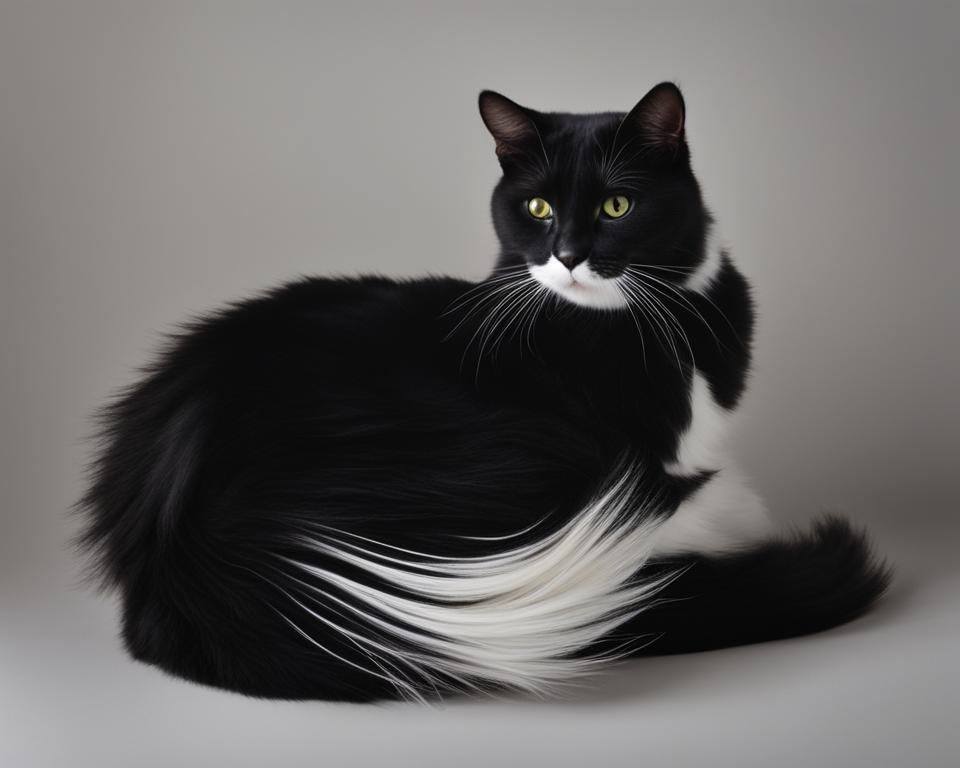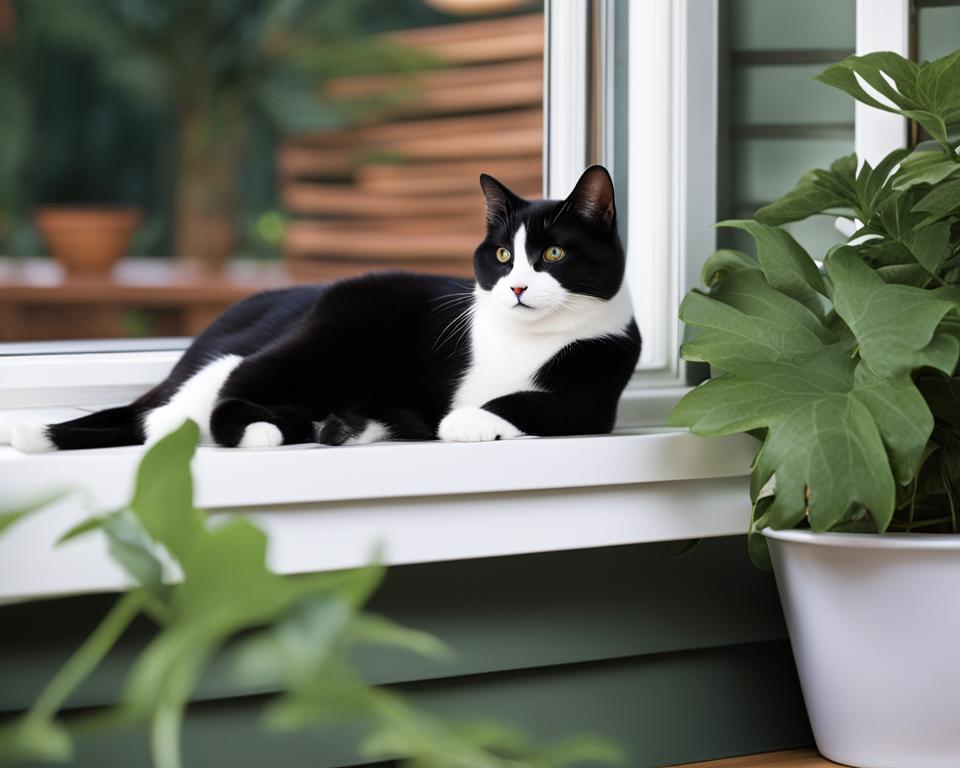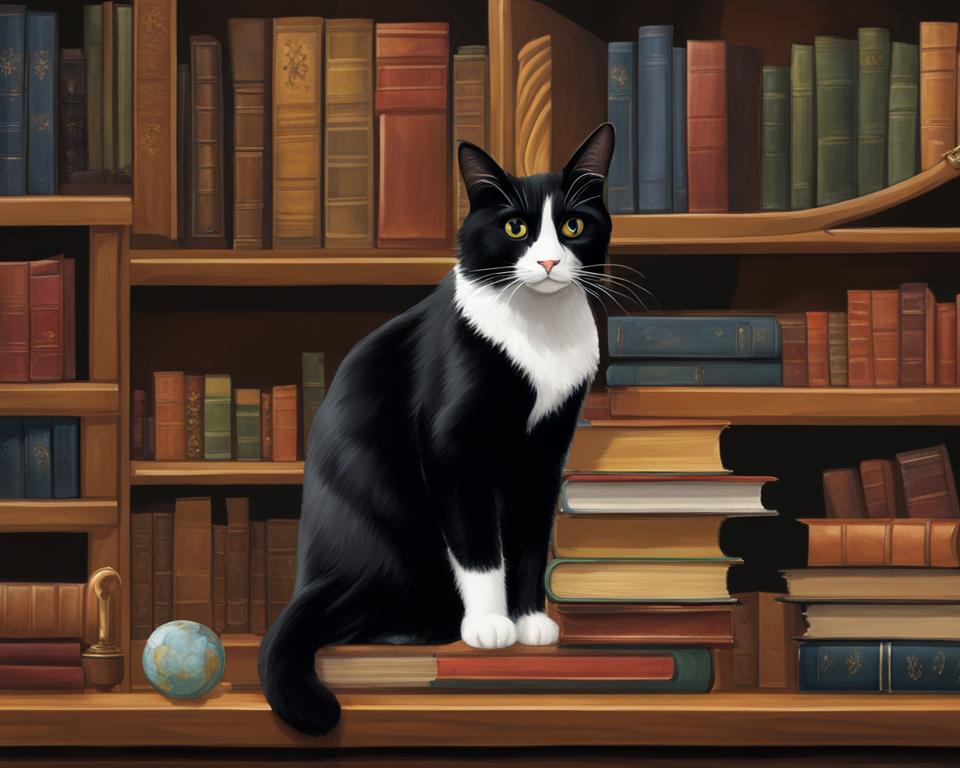Tuxedo cats, with their striking black and white coats, have a unique blend of beauty and personality. They are not limited to one specific breed but can be found in various feline lineages. Tuxedo cats are known for their outgoing and sociable nature, affinity for human company, and playful and mischievous side.
Key Takeaways:
- Tuxedo cats have striking black and white coats, making them distinct and visually appealing.
- They are known for their outgoing and sociable nature, enjoying the company of humans.
- Tuxedo cats have a playful and mischievous side, adding fun and entertainment to any household.
- Their unique personality traits make them a popular choice for families and individuals looking for an engaging pet.
- Understanding tuxedo cat behavior can help ensure a nurturing and fulfilling relationship with these remarkable feline companions.
The Fascinating Origins of Tuxedo Cats: Exploring Their Coat Pattern and Name
Tuxedo cats have a distinctive coat pattern that sets them apart from other feline companions. Their name is derived from the resemblance between their coat pattern and a formal man’s attire. The unique black and white markings on their fur create a striking visual appeal that captures the attention of cat lovers worldwide.
The coat pattern of tuxedo cats is not determined by a single gene but is a result of a complex combination of genes that regulate the distribution of pigment in their fur. These genes interact in intricate ways, producing the distinct black and white patterns seen in tuxedo cats. It is fascinating to explore how these genetic factors contribute to the formation of their eye-catching coat pattern.
Tuxedo cats can be found in various breeds, and their coat patterns can vary. Some tuxedo cats have more black than white, while others display more white than black. This diversity adds to the charm and uniqueness of these feline companions. The origins of the tuxedo cat coat pattern and the specific breeds associated with it are a topic of interest for cat enthusiasts and researchers alike.
| Tuxedo Cat Coat Pattern | Characteristics |
|---|---|
| Black Dominant | A tuxedo cat with more black fur than white, giving it a predominantly dark appearance. |
| White Dominant | A tuxedo cat with more white fur than black, creating a striking contrast and emphasizing the white markings. |
| Equal Distribution | A tuxedo cat with an equal amount of black and white fur, resulting in a balanced and symmetrical coat pattern. |
The coat pattern of tuxedo cats is a testament to the fascinating world of genetics and the intricate mechanisms that shape the physical characteristics of animals. Understanding the origins and genetics behind the coat pattern of tuxedo cats adds deeper insight into their unique and captivating nature.
Unraveling the Genetics of Tuxedo Cats: Understanding the Complex Interplay of Genes
Tuxedo cats, with their distinctive black and white coat patterns, have long intrigued researchers and cat enthusiasts alike. The genetics behind these striking patterns are complex and involve the interplay of various genes that regulate the distribution of pigment in their fur. Understanding the genetic mechanisms responsible for the formation of tuxedo cats’ coat patterns can provide valuable insights into their unique appearance.
While the precise details of tuxedo cat genetics are still being studied, researchers have identified that the coat pattern is not determined by a single gene. Instead, it is a combination of genes that interact to produce the characteristic black and white markings. The genetics of coat color in cats is fascinating, and tuxedo cats’ patterns are a result of intricate genetic variations.
One of the key genes involved in the coat color of tuxedo cats is the KIT gene, which plays a crucial role in determining the distribution of pigment cells during embryonic development. Variations in this gene can lead to different coat patterns, including the classic tuxedo pattern. Other genes, such as the MC1R gene, also contribute to the coloration and patterning of a tuxedo cat’s fur.
Genetics of tuxedo cat coat pattern:
| Gene | Function | Role in Tuxedo Coat Pattern |
|---|---|---|
| KIT gene | Determines distribution of pigment cells | Variations in this gene can lead to tuxedo coat pattern |
| MC1R gene | Affects melanin production | Contributes to the coloration of tuxedo cats’ fur |
| TYR gene | Regulates melanin production | Plays a role in the coloration of tuxedo cats’ fur |
It’s important to note that genetics alone do not determine a tuxedo cat’s personality or behavior. While coat patterns can be influenced by genetics, factors such as socialization, environment, and individual experiences also play significant roles in shaping a cat’s behavior and temperament.
Studying the genetics of tuxedo cats not only deepens our understanding of their unique coat patterns but also highlights the intricate nature of feline genetics. By unraveling the complex interplay of genes involved in tuxedo cats’ appearance, researchers can shed light on the fascinating world of feline genetics and the diversity of coat patterns found in cats.

Debunking Myths About Tuxedo Cats: Separating Fact from Fiction
Tuxedo cats have captured the hearts of many cat lovers with their striking black and white coats and charming personalities. However, there are several misconceptions surrounding these unique felines. Let’s debunk some of the common myths and separate fact from fiction.
Myth: Tuxedo cats are always male
Fact: While it’s true that the tuxedo coat pattern is more commonly seen in male cats, females can also exhibit this distinctive coloration. The tuxedo pattern is not exclusive to a particular gender or breed. It can be found in various cat breeds and mixed-breed cats.
Myth: Tuxedo cats are aggressive or aloof
Fact: Tuxedo cats are often misunderstood as being aggressive or aloof due to their striking appearance. However, this stereotype is far from the truth. Tuxedo cats are known for their engaging personalities, social nature, and affectionate behavior. They enjoy the company of humans and are often friendly and playful.
Myth: Tuxedo cats have a specific breed origin
Fact: Unlike some cat breeds that have specific origins, tuxedo cats are not associated with a particular breed. The tuxedo coat pattern can be found in a variety of breeds and mixed-breed cats. It is the result of genetic factors that regulate the distribution of pigment in their fur.
| Myth | Fact |
|---|---|
| Tuxedo cats are always male | The tuxedo coat pattern can be seen in both male and female cats. |
| Tuxedo cats are aggressive or aloof | Tuxedo cats are known for their engaging personalities and affectionate nature. |
| Tuxedo cats have a specific breed origin | Tuxedo cats can come from various breeds and mixed-breed backgrounds. |
Now that we have debunked some of the myths surrounding tuxedo cats, it’s important to appreciate these feline companions for who they truly are. They are not defined by stereotypes but rather by their unique beauty, engaging personalities, and loving nature. Whether male or female, tuxedo cats make wonderful companions and bring joy to the lives of their human counterparts.
The Enduring Appeal of Tuxedo Cats: More Than Just Looks
Tuxedo cats are more than just a pretty face. Beyond their striking appearance, these feline companions possess unique qualities that make them beloved by cat enthusiasts around the world. From their engaging personalities to their cultural significance, tuxedo cats have captured the hearts of many.
The Unique Qualities of Tuxedo Cats
Tuxedo cats are known for their intelligence, adaptability, and ability to form deep bonds with their human companions. They have a reputation for being friendly, outgoing, and sociable, making them excellent companions for families and individuals alike. Tuxedo cats are often described as being playful and mischievous, bringing joy and laughter to their households.
In addition, tuxedo cats are highly adaptable to various environments and can thrive both indoors and outdoors. They have a curious nature and love exploring their surroundings, satisfying their natural instincts. Despite their independent streak, tuxedo cats also enjoy being part of a loving household and thrive on human interaction.
The Cultural Significance of Tuxedo Cats
Tuxedo cats hold cultural significance in various parts of the world. In Japanese folklore, these cats are believed to bring good luck, prosperity, and protection against evil spirits. They are often regarded as symbols of intelligence and are associated with wisdom and good fortune.
In popular culture, tuxedo cats have made their mark as well. From classic literature to animated movies, these cats have been portrayed as stylish, sophisticated, and sometimes even as heroes. Their unique coat pattern has captured the attention of many, further enhancing their appeal.
| Tuxedo Cats – Unique Qualities and Cultural Significance |
|---|
| Engaging personalities |
| Intelligence and adaptability |
| Deep bonds with human companions |
| Cultural significance in various parts of the world |
| Symbolism of good luck, prosperity, and protection against evil spirits |
| Popularity in literature, movies, and popular culture |
Nurturing Tuxedo Cat Behaviors: Tips for Keeping Them Happy and Healthy
Tuxedo cats, with their unique personalities and striking appearance, require proper care to ensure their well-being and happiness. Here are some essential tips for nurturing the behaviors of your beloved tuxedo cat:
1. Provide a Balanced Diet:
A well-balanced diet is crucial for the overall health of your tuxedo cat. Ensure that their meals consist of high-quality cat food with the right balance of protein, carbohydrates, and essential nutrients. Avoid feeding them excessive amounts of treats or human food, as it can lead to weight gain and health issues. Consult with your veterinarian to determine the best diet plan for your tuxedo cat’s specific needs.
2. Regular Veterinary Check-ups:
Regular veterinary check-ups are essential for monitoring your tuxedo cat’s health and detecting any potential issues early on. Schedule annual wellness exams and vaccinations to ensure they stay up-to-date with their preventive care. Your veterinarian can also provide advice on parasite prevention, dental care, and any specific health concerns related to tuxedo cats.
3. Exercise and Mental Stimulation:
Tuxedo cats are active and playful, so it’s important to provide them with regular exercise and mental stimulation. Engage in interactive play sessions with toys that encourage them to chase, pounce, and use their natural hunting instincts. Provide scratching posts, puzzle toys, and vertical spaces like cat trees or shelves for them to climb and explore. This will help keep them physically fit and mentally stimulated.
4. Grooming and Hygiene:
Tuxedo cats, like any other cats, require regular grooming to keep their coats healthy and free from tangles and matting. Brush their fur regularly to remove loose hair and prevent the formation of hairballs. Check their ears regularly for signs of infection or excessive wax buildup. Trim their nails, and if necessary, consult a professional groomer for assistance. Remember to also provide a clean litter box and maintain good hygiene in their living environment.
By following these tips, you can provide the necessary care and attention that your tuxedo cat needs to thrive. Remember, each tuxedo cat has its own unique personality, so be sure to observe and adapt your care routine based on their individual preferences and behaviors.

Tuxedo Cats in Pop Culture: From Feline Fashion Icons to Internet Sensations
Tuxedo cats have ingrained themselves in popular culture, becoming beloved figures in movies, literature, and the vast realm of social media. These charming felines, with their distinctive black and white coats, have stolen the hearts of cat lovers around the world.
One of the most famous tuxedo cats in pop culture is none other than Sylvester the cat, who made his debut in the iconic Looney Tunes cartoons. With his endless pursuit of Tweety Bird and his comical antics, Sylvester showcased the mischievous and playful nature often associated with tuxedo cats.
In the digital age, tuxedo cats have risen to stardom on social media platforms like Instagram. These feline fashionistas display their unique style and captivating personalities, captivating audiences with their charm. Some notable tuxedo cat celebrities on Instagram include the dapper Sir Thomas Trueheart and the adorable duo of Rin and Seri, who have amassed a large following.
With their stylish appearance and engaging personalities, tuxedo cats continue to leave a lasting impression on pop culture. Whether gracing the silver screen or delighting fans on social media, these black and white beauties have solidified their place as iconic symbols of feline elegance and wit.
FAQ
Are tuxedo cats a specific breed?
No, tuxedo cats can come from various breeds. The tuxedo coat pattern can be found in different feline lineages.
Do all tuxedo cats have more black than white in their coat?
No, the amount of black and white in a tuxedo cat’s coat can vary. Some cats have more black than white, while others have more white than black.
Are tuxedo cats always male?
No, tuxedo cats can be both male and female. The tuxedo coat pattern is not limited to one gender.
Are tuxedo cats more aggressive or aloof compared to other cats?
No, tuxedo cats are not more aggressive or aloof than other cats. They are known for their engaging personalities and affectionate nature.
What care do tuxedo cats require?
Tuxedo cats require a balanced diet, regular veterinary check-ups, exercise, mental stimulation, grooming, a safe environment, and a loving household for their well-being and happiness.
Do tuxedo cats have any cultural significance?
Yes, tuxedo cats hold cultural significance in various parts of the world, symbolizing prosperity, intelligence, and protection against evil spirits.
Have tuxedo cats appeared in pop culture?
Yes, tuxedo cats have made their mark in pop culture, appearing in movies, literature, and social media. They have captured the attention and adoration of cat lovers worldwide.

Leave a Reply